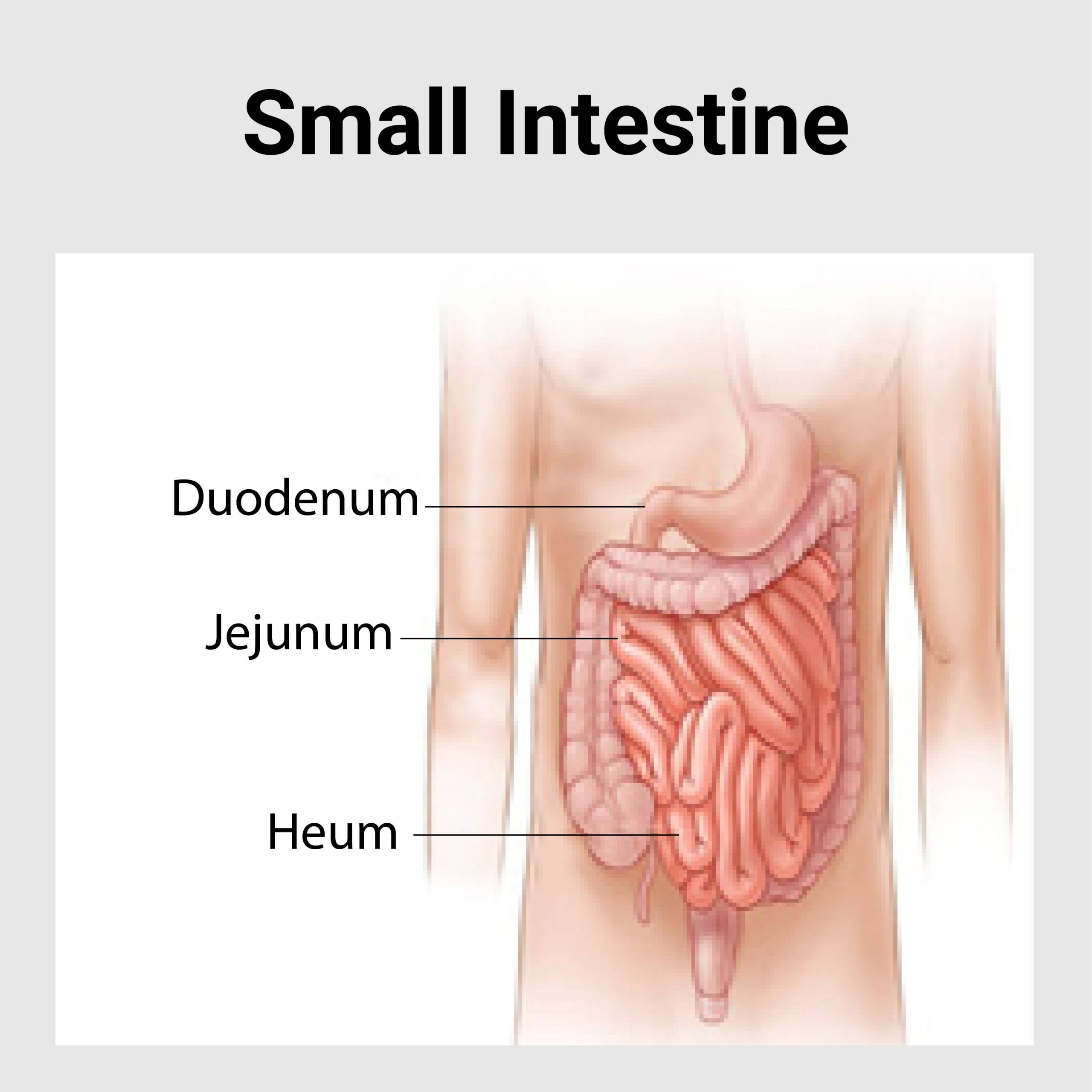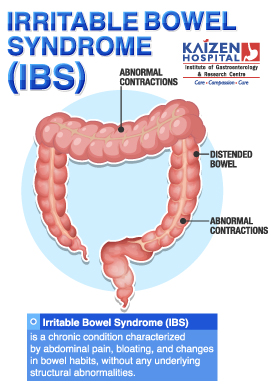Small Intestine Disease

The small intestine or small bowel is the part of the gastrointestinal tract between the stomach and the large intestine, The small intestine has three distinct regions – the duodenum,jejunum, and ileum
The average length of the small intestine in an adult human male is 6.9 m (22 ft 8 in), and 7.1 m (23 ft 4 in) in an adult female. The small intestine is divided into three structural parts.
The duodenum is a short structure (about 20-25 cm long) continuous with the stomach and shaped like a “C”. It surrounds the head of the pancreas.
The jejunum is the midsection of the small intestine, connecting the duodenum to the ileum. It is about 2.5 m long, and contains the plicae circulares, and villi that increase its surface area. Products of digestion
(sugars, amino acids, and fatty acids) are absorbed into the bloodstream here. The suspensory muscle of duodenum marks the division between the duodenum and the jejunum.
The iluem The final section of the small intestine. It is about 3 m long, and contains villi similar to the jejunum. It absorbs mainly vitamin B12andbile acids, as well as any other remaining nutrients. The ileum joins to the cecum of the arge intestine at the ileocecal junction.
- Intestinal Obstruction
- Crohn’s Disease
- Intestine Perforation
- Intestinal Gangrene
- Meckel Diverticulum
- Intestinal Intussusception
- Cancer of Small Intestine
Intestinal Obstruction
Intestinal obstruction or bowel obstruction is a partial or complete blockage of the intestine or bowel that prevents intestinal content from passing through. The obstruction could be a mechanical or functional in nature. An untreated intestinal obstruction can be fatal.
Signs & Symptoms
Intestinal obstruction can cause wide spectrum of uncomfortable symptoms such as:
- Abdominal pain
- Severe bloating
- Severe abdominal cramps
- Abdominal swelling
- Loss of appetite
- Nausea
- Vomiting
- High fever
Causes
Intestinal obstruction can be caused by something blocking part of the intestine (mechanical) or malfunctioning of the intestine (functional). Sometime after surgery fibrous band of tissues are formed in the abdomen which causes adhesions and blocks the natural passage. Inflamed or infected pouches in the intestine known as diverticulitis, hernias and tumors can also cause blockage of intestinal passage.
Various causes of intestinal obstruction include:
- Adhesions: band of fibrous tissue in the abdominal cavity causes intestinal adhesions
- Colon cancer: Tumors in the intestine
- Volvulus: twisting of the small intestine
- Hernia: portions of intestine protrude into another part of the body
- Inflammatory disease like crohn’s disease: swelling and scar tissue causes a narrowing of the intestine
- Severe constipation leads to impacted bowel
- Paralytic ileus: intestine temporarily ceases contracting and moving its contents along
- Intusscuception: one section of intestine collapses into another
- Ingestion of foreign objects
- Strangulation: decreased blood flow to the intestines usually due to birth defect
- Stricture and inflammation causes narrowing of intestine
Risk Factors
- Abdominal or pelvic surgery
- Inflammatory disease like crohn’s disease
- Abdominal tumors
Complications
- Infection in the abdominal cavity known as peritonitis
- Intestinal obstruction can cut off blood supply to certain part of the intestine which causes the intestinal tissues to die this will result in perforation and can lead to infection
Diagnosis
- Abdominal X-ray: In this procedure you have to swallow a contrast liquid and the x-ray technician visualizes the intestinal tract to look for obstruction.
- Abdominal CT scan: this test help determine if the obstruction is partial or complete and whether it is mechanical or functional obstruction.
- Physical examination: to look for swollen or tender abdomen or if there is a lump in abdomen associated with the signs and symptoms of intestinal obstruction. Typical abdominal sound of obstruction can be heard using stethoscope.
- Colonoscopy: if the obstruction is located in large intestine colonoscopy can be performed to inspect the large intestine.
Treatment
Intestinal obstruction is a medical emergency and requires prompt medical treatment. Appropriate treatment depends on the type and location of obstruction however most intestinal obstructions require surgery.
Crohn’s Disease

Causes
- Immunity factors
- Environmental factors – Stress, smoking, hormonal contraceptives.
- Genetics
- Micro-organisms
Signs and Symptoms
- Abdominal pain
- Diarrhoea – bloody or non bloody
- Bloating, flatulence
- Fever
- Cachexia
- Anaemia
- Fatigue
- Arthritis
- Erythema nodosum
- Pyoderma gangrenosum
- Arthritis
- Skin rashes
- Ankylosing Spondylosis
- Osteoporosis
- Clubbing
Diagnosis
- CBC
- ESR
- CRP
- Ferritin
- Folates
- Vitamin B12
- ASCA
- ANCA
- Colonoscopy with biopsy
- Capsule Endoscopy
- Barium Follow Through
- Barium Enema
Management
- Lifestyle modifications
- Maintain hydration.
- Avoid smoking.
- High fibre diet.
- Antibiotics
- Anti-inflammatory drugs
- Corticosteroids
- Iron supplements
- Surgery – if disease does not respond to drugs or in case of any complications
Complications
- Bowel Obstruction
- Fistulae
- Abscesses
- Small intestinal cancer
- Malnutrition
- Perforation
- Haemorrhage
Intestine Perforation
It is a complication of underlying duodenal disease like Duodenal ulcer, Duodenal cancer or it may be due to complication of ERCP or UGI endoscopic procedures.
Causes
- Blunt abdominal trauma.
- Penetrating injury to the lower chest or abdomen (e.g. stab injuries).
- Bacterial infections
- Ingestion of aspirin, non steroidal anti-inflammatory drugs (NSAIDs), and steroids.
- Inflammatory bowel disease (IBD).
- Predisposing conditions – Peptic ulcer disease, acute appendicitis, acute diverticulitis, and inflammed Meckel diverticulum.
- Endoscopy related bowel injuries- Endoscopic biliary stenting, Colonoscopy, ERCP.
- Laparoscopic intestinal injury.
- Bowel perforation by intra-abdominal malignancy, lymphoma, or metastatic renal carcinoma – Even benign tumours, such as desmoid tumours.
- Radiotherapy of cervical carcinoma and other intra-abdominal malignancies.
- Perforation secondary to intestinal ischemia (e.g. ischaemic colitis)
- Necrotizing vasculitis.
- Kidney transplantation
- Foreign bodies (e.g. toothpicks).
- Ingestion of caustic substances – Accidental or suicidal ingestion.
Signs and Symptoms
- Abdominal pain- Sharp, severe, sudden in onset.
- Vomiting
- Hiccoughs
- Board-like rigidity of abdomen with tenderness
- Tachycardia
- Fever
- Absence of bowel sounds
Diagnosis
- CBC
- LFT
- RFT
- Blood culture
- X Ray Abdomen Erect
- Chest PA
- USG Abdomen
- CT Scan
- Laparoscopy
Treatment
- Intravenous access, and crystalloid therapy in patients with clinical signs of dehydration or septicaemia.
- Do not give anything by mouth.
- Intravenous administration of antibiotics.
- Surgery for duodenal perforation
Complications of Duodenal perforation.
- Localized abdominal abscess
- Wound infection
- Mechanical intestinal obstruction
- Postoperative delirium
- Multi organ failure
- Gastrointestinal mucosal hemorrhage
- Fluid and electrolyte imbalance
- Renal failure
- Septic shock
Intestinal Gangrene
Causes
- Acute mesenteric arterial thrombosis
- Acute mesenteric arterial embolism
- Non occlusive mesenteric ischemia
- Mesenteric venous thrombosis
Signs and Symptoms
- Moderate to severe, diffuse, non localized, constant, and sometimes colicky abdominal pain.
Abdominal distention - Nausea, vomiting
- Anorexia
- Constipation
- Diarrhoea
- Tachycardia
- Tachypnoea
- Fever
- Hypotension
- Tender mass on palpation.
- Bowel sounds – hyperactive to absent.
- Voluntary and involuntary guarding appears.
Diagnosis
- CBC
- PT, APTT
- X Ray Abdomen erect
- USG Abdomen
- CT Scan
- CT Angiography
- MRI
- MR Angiography
Treatment
- Medicines
- Vasodilators
- Anticoagulants
- Thrombolytics
- Analgesics
- Antibiotics
- Surgery
Complications
- Sepsis and septic shock
- Bowel necrosis necessitating bowel resection
- Multiple organ dysfunction syndrome (MODS)
- Death
Meckel Diverticulum
Symptoms
- Intestinal obstruction
- Bloody stool
- Abdominal pain
- Anaemia
Diagnosis
- Blood tests
- Stool smear
- USG Abdomen and Pelvis
- Technitium Scan
- UGI scopy
- Colonoscopy
- CT with Angiography
Treatment
- Surgery – Laparoscopic Small Bowel Resection
Complications
- Intestinal Obstruction
- Diverticulitis
- Haemorrhage
- Umbilical anomalies
- Neoplasm
Intestinal Intussusception
Cases
- Children – idiopathic
- Adults
- Inflammation e.g.Crohn Disease
Haematoma
- Surgical scars in small intestine and colon
Adhesions
- Tumour
Symptoms
- Severe intermittent abdominal pain
- Diarrhoea mixed with blood and mucus
- Constipation
- Lumpish feeling in abdomen
- Vomiting
- Fever
- Lethargy
Diagnosis
- X Ray Abdomen
- Ultrasound
- Barium Enema
- CT Scan
Treatment
- Correct dehydration by IV fluids
- Nasogastric tube insertion
- Surgery
Complications
- Decreased blood supply to intestines – gangrene
- Bowel perforation
- Peritonitis
Cancer of Small Intestine
- Age- More commonly seen in age groups above 60.
- Sex- More in males.
- Smoking
- Alcohol
- Celiac Disease
- Crohn’s Disease
- Exposure to radiation
- Cystic Fibrosis
- Koch’s
- Hamartoma
- Fistulous diseases
Symptoms
- Abdominal pain
- Anorexia
- Cachexia
- Anaemia
- Weakness and fatigue
- Nausea, vomiting
Diagnosis
- Medical history and physical exam
- CBC
- CT Scan
- Upper GI Endoscopy
- Colonoscopy
- Barium follow through
- Enteroclysis
- Barium enema
- Capsule endoscopy
- Double-balloon enteroscopy (endoscopy)
Treatment
- Treatment depends on patient’s age, health status and cancer stage.
- Surgery
- Chemotherapy
- Radiotherapy
HOSPITAL ADDRESS
132ft. Ring Road, Helmet Circle, Memnagar, Ahmedabad – 380052. Gujarat, India.
EMERGENCY( 24X7 )
Mobile: +91 – 99047 44410
Help Line : +91 – 98244 40044
+91 – 79 – 2791 4444
E-MAIL ADDRESS
contact@xdemo.app
WHY KAIZEN ?
With a vision to extend World Class healthcare solutions to the community through advances in medical technology, medical research and by adopting best man power management practices , Kaizen hospital was established in Ahmedabad in 2011.

